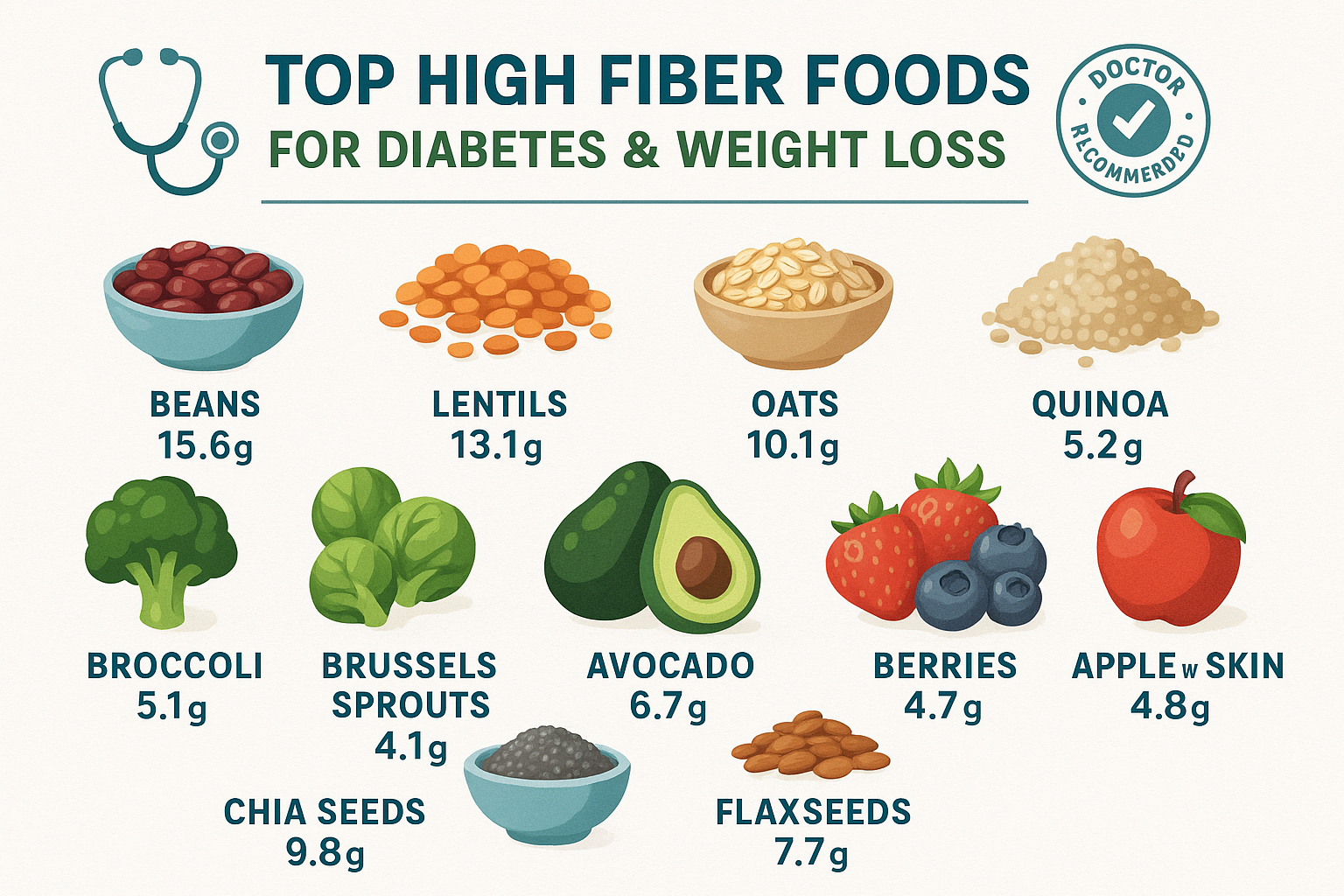
Top High Fiber Foods for Diabetes & Weight Loss: Doctor Recommended List
The Fiber Factor: Your Secret Weapon for Metabolic Health
In the complex world of nutrition advice, one recommendation stands out with remarkable consistency across medical research and clinical practice: eat more fiber. For individuals managing diabetes or working toward sustainable weight loss, dietary fiber emerges as perhaps the most powerful nutritional tool available—yet it remains chronically under-consumed in modern diets.
The average American consumes merely 15 grams of fiber daily, falling drastically short of the recommended 25-38 grams. This fiber deficit contributes significantly to the epidemic of metabolic disorders, weight gain, and blood sugar dysregulation affecting millions worldwide.
Fiber, the indigestible portion of plant foods, offers extraordinary benefits that extend far beyond digestive regularity. For people with diabetes, fiber slows glucose absorption, preventing dangerous blood sugar spikes. For those pursuing weight loss, fiber increases satiety, reduces calorie intake, and supports the metabolic processes that facilitate fat burning. Most remarkably, these benefits come without medication side effects, complicated protocols, or significant expense—just real, whole foods.
This comprehensive guide explores the top doctor-recommended high-fiber foods, with specific focus on fiber-rich fruits and green vegetables. You'll discover not just what to eat, but why these foods work, how to incorporate them strategically, and how to maximize their metabolic benefits for blood sugar control and sustainable weight management.
Understanding Fiber: Soluble vs. Insoluble
Before diving into specific foods, it's important to understand that not all fiber is created equal. Dietary fiber divides into two categories, each offering distinct benefits:
Soluble Fiber dissolves in water, forming a gel-like substance in the digestive tract. This type of fiber is particularly valuable for blood sugar control and cholesterol management. It slows the absorption of sugar into the bloodstream, preventing the rapid spikes that challenge diabetics and trigger insulin resistance. Soluble fiber also binds to cholesterol particles, helping remove them from the body. Foods particularly rich in soluble fiber include oats, beans, apples, citrus fruits, and psyllium.
Insoluble Fiber doesn't dissolve in water and passes through the digestive system relatively intact. This fiber adds bulk to stool, promotes regularity, and feeds beneficial gut bacteria. While less directly involved in blood sugar control, insoluble fiber supports weight loss by increasing satiety and promoting healthy gut microbiome diversity. Green vegetables, wheat bran, and the skins of many fruits provide abundant insoluble fiber.
For optimal health, particularly when managing diabetes or pursuing weight loss, both types are essential. Fortunately, most high-fiber whole foods contain a mix of both soluble and insoluble fiber, making it unnecessary to track them separately when eating a varied plant-based diet.
How Fiber Supports Blood Sugar Control
For individuals with diabetes or prediabetes, fiber functions as a natural blood sugar regulator through several mechanisms:
Slowed Glucose Absorption: Soluble fiber creates a viscous gel in the intestines that slows the breakdown and absorption of carbohydrates, resulting in gradual rather than rapid increases in blood glucose. This prevents the dangerous spikes that damage blood vessels and nerves over time.
Improved Insulin Sensitivity: Research published in Diabetes Care demonstrates that high-fiber diets improve insulin sensitivity, meaning cells respond more effectively to insulin's signals to take up glucose from the bloodstream. This reduces the amount of insulin needed to manage blood sugar levels.
Reduced Glycemic Load: High-fiber foods typically have lower glycemic indices, meaning they cause smaller, slower rises in blood sugar compared to low-fiber refined foods. The fiber content effectively reduces the glycemic impact of the entire meal.
Enhanced Incretin Response: Fiber stimulates the release of incretin hormones from the intestines, which help regulate insulin secretion in response to food intake, improving overall glycemic control.
Multiple studies confirm these benefits. A meta-analysis in the Journal of the American Board of Family Medicine found that each additional 10 grams of daily fiber intake reduced HbA1c levels (a measure of long-term blood sugar control) by approximately 0.25%—a clinically meaningful improvement that reduces diabetes complications risk.
How Fiber Facilitates Weight Loss
For sustainable weight loss, fiber offers advantages that no pharmaceutical intervention can match:
Increased Satiety: Fiber-rich foods are more filling than refined alternatives, reducing overall calorie intake without conscious restriction. Research in Nutrition Reviews found that increased fiber intake was associated with significant weight loss even without deliberate calorie restriction.
Reduced Calorie Absorption: Some fiber types slightly reduce the digestibility and absorption of other nutrients, effectively lowering the caloric value of meals.
Gut Microbiome Support: Fiber serves as food for beneficial gut bacteria, which produce short-chain fatty acids that may influence metabolism, inflammation, and fat storage. A healthy microbiome is increasingly recognized as crucial for weight management.
Hormonal Regulation: High-fiber diets favorably influence hunger and satiety hormones including ghrelin, leptin, and peptide YY, helping regulate appetite naturally.
Stabilized Energy: By preventing blood sugar crashes that trigger cravings and overeating, fiber helps maintain steady energy and reduces the impulse to consume high-calorie foods.
A landmark study in the Annals of Internal Medicine found that simply increasing fiber intake to 30 grams daily—without other dietary changes—resulted in significant weight loss comparable to more complex diet interventions.
Top High-Fiber Fruits for Diabetes and Weight Loss
Fruits often face undeserved scrutiny in diabetes and weight loss contexts due to their natural sugar content. However, high-fiber fruits provide essential nutrients, antioxidants, and satisfaction that support metabolic health when consumed appropriately.
Berries: The Low-Sugar Fiber Champions
Raspberries lead all fruits in fiber content, delivering an impressive 8 grams of fiber per cup with only 64 calories and 5 grams of net carbohydrates (total carbs minus fiber). Their low glycemic impact makes them ideal for blood sugar management. Raspberries contain powerful antioxidants including ellagic acid and anthocyanins that reduce inflammation and oxidative stress associated with diabetes complications.
Blackberries provide 7.6 grams of fiber per cup with similar low glycemic properties. They're particularly rich in vitamins C and K and contain compounds that may improve insulin sensitivity.
Strawberries, while containing slightly less fiber at 3 grams per cup, offer excellent nutritional density with minimal blood sugar impact. Their high vitamin C content supports immune function often compromised in diabetes.
Blueberries deliver 3.6 grams of fiber per cup alongside remarkable cognitive and cardiovascular benefits. Research suggests their anthocyanins may improve insulin sensitivity and glucose metabolism.
Practical Application: Berries make excellent snacks, breakfast additions, or dessert alternatives. Their fiber-to-sugar ratio prevents blood sugar spikes while satisfying sweet cravings. Frozen berries retain nutritional value and provide year-round affordability.
Apples: The Soluble Fiber Powerhouse
The saying "an apple a day keeps the doctor away" holds particular truth for diabetes and weight management. A medium apple with skin provides approximately 4.4 grams of fiber, with significant pectin content—a soluble fiber exceptionally effective for blood sugar control and cholesterol reduction.
Research in the Journal of Functional Foods found that apple consumption improved glycemic control and reduced inflammation markers in individuals with type 2 diabetes. The key is eating the whole fruit with skin intact, where much of the fiber and polyphenol antioxidants concentrate.
For weight loss, apples' high water content combined with fiber creates substantial satiety for minimal calories (approximately 95 calories for a medium apple). Studies show that eating an apple before meals can reduce overall calorie intake by promoting fullness.
Practical Application: Choose tart varieties like Granny Smith for the lowest glycemic impact. Eat apples with their skin, perhaps paired with a protein source like almond butter to further stabilize blood sugar response.
Pears: The Underappreciated Fiber Source
Pears rival apples in fiber content, providing approximately 5.5 grams per medium fruit. They contain both soluble and insoluble fiber, with particularly high pectin concentrations that support blood sugar regulation.
Research indicates that regular pear consumption is associated with lower body weight and reduced risk of metabolic syndrome. The fruit's high water content (about 84%) combined with fiber creates exceptional satiety relative to caloric content.
Practical Application: Like apples, pears should be eaten with skin for maximum fiber benefit. Their natural sweetness satisfies dessert cravings while providing nutritional value that processed sweets lack.
Avocados: The Unique Fiber-Fat Combination
Though often overlooked as a fruit, avocados provide an extraordinary nutritional profile for diabetes and weight management. One medium avocado delivers approximately 10 grams of fiber—more than most other fruits—combined with heart-healthy monounsaturated fats that enhance satiety and support cardiovascular health often compromised in diabetes.
Studies published in Nutrition Journal found that including avocado in meals significantly increased satiety and reduced desire to eat for up to five hours. The combination of fiber and healthy fat slows digestion and stabilizes blood sugar remarkably well.
Despite their higher calorie content (about 240 calories per avocado), research suggests avocado consumption supports rather than hinders weight loss, likely due to their exceptional satiety effects and beneficial impact on metabolism.
Practical Application: Half an avocado makes an excellent addition to salads, whole grain toast, or as a creamy base for smoothies. The combination of fiber, healthy fats, and minimal sugar creates ideal metabolic effects.
Oranges and Grapefruit: Citrus Fiber Stars
Whole citrus fruits (not juice) provide excellent fiber alongside vitamin C and beneficial plant compounds. A medium orange delivers approximately 3 grams of fiber, while grapefruit provides about 2 grams per half.
Grapefruit has garnered particular attention for weight loss. A study in Metabolism found that eating half a grapefruit before meals resulted in significant weight loss and improved insulin resistance. The combination of fiber, low energy density, and potentially beneficial compounds like naringenin creates favorable metabolic effects.
Critical Note: Grapefruit can interact with numerous medications by affecting how they're metabolized. Anyone taking prescription medications should consult their healthcare provider before regularly consuming grapefruit.
Practical Application: Eat whole citrus fruits rather than juice to retain fiber. The white pith beneath the peel contains additional beneficial compounds and fiber, so don't remove it completely.
Other Notable Fiber-Rich Fruits
Kiwis: Provide approximately 5 grams of fiber per two medium fruits, with particularly beneficial effects on digestion and blood sugar control.
Passion Fruit: Contains about 2 grams of fiber per fruit, with seeds providing much of the fiber content.
Figs (fresh, not dried): Offer approximately 1.5 grams of fiber per medium fig, though dried versions concentrate both fiber and sugar, requiring portion awareness.
Top High-Fiber Green Vegetables for Diabetes and Weight Loss
Green vegetables represent the nutritional foundation of any diet focused on blood sugar control and weight management. They combine high fiber content with minimal calories and carbohydrates, making them virtually unlimited foods even for diabetics.
Leafy Greens: The Fiber-Dense Nutrient Powerhouses
Spinach provides approximately 4 grams of fiber per cooked cup (about 1 gram per raw cup) with only 41 calories when cooked. It's extraordinarily nutrient-dense, providing vitamins A, C, K, folate, iron, and magnesium—many of which are depleted in diabetics.
Kale delivers approximately 2.6 grams of fiber per cooked cup with exceptional antioxidant content. Its glucosinolates and flavonoids provide anti-inflammatory and potentially anti-diabetic effects.
Collard Greens offer about 5.3 grams of fiber per cooked cup, making them among the highest-fiber leafy greens. They're particularly rich in vitamin K and calcium.
Swiss Chard provides approximately 3.7 grams of fiber per cooked cup alongside betalains—unique antioxidants with anti-inflammatory properties beneficial for metabolic health.
Practical Application: Leafy greens can be consumed raw in salads, sautéed with garlic and olive oil, blended into smoothies, or added to soups and stews. Their minimal caloric impact allows generous portions that increase meal volume and satiety without significantly affecting blood sugar or calorie intake.
Broccoli: The Cruciferous Fiber Star
Broccoli ranks among the most studied vegetables for metabolic health, providing approximately 5 grams of fiber per cooked cup with only 55 calories. It contains sulforaphane, a compound extensively researched for its potential to improve insulin sensitivity and glucose metabolism.
A study in Science Translational Medicine found that concentrated broccoli sprout extract improved glycemic control in obese patients with type 2 diabetes, suggesting powerful metabolic benefits from cruciferous vegetables.
Beyond blood sugar control, broccoli's fiber and low energy density make it exceptional for weight loss. Research consistently shows that increased cruciferous vegetable consumption is associated with lower body weight and reduced diabetes risk.
Practical Application: Lightly steaming preserves more nutrients and fiber than boiling. Roasting broccoli caramelizes its natural sugars, creating appealing flavor without added calories. Raw broccoli florets make excellent crudité for fiber-rich snacking.
Brussels Sprouts: Miniature Fiber Packages
These compact cruciferous vegetables deliver approximately 4 grams of fiber per cooked cup with only 56 calories. Like broccoli, they contain glucosinolates that support detoxification and may improve insulin sensitivity.
Brussels sprouts' combination of fiber, protein (about 4 grams per cup), and minimal carbohydrates creates ideal macronutrient ratios for blood sugar control and satiety.
Practical Application: Roasting Brussels sprouts at high temperature (around 400°F) creates crispy, caramelized exteriors that transform skeptics into enthusiasts. Slicing them thin for raw salads provides exceptional crunch and fiber.
Green Beans: The Versatile Fiber Source
Green beans provide approximately 4 grams of fiber per cooked cup with only 44 calories and minimal blood sugar impact. They're particularly rich in vitamins C and K and contain beneficial plant compounds including carotenoids.
Their mild flavor and versatility make them accessible to even picky eaters, increasing adherence to high-fiber eating patterns.
Practical Application: Steam, sauté, or roast green beans. Adding almonds creates a classic combination that increases both fiber and healthy fat content, further stabilizing blood sugar response.
Asparagus: The Prebiotic Fiber Champion
Asparagus delivers approximately 2.8 grams of fiber per cooked cup, with particularly high inulin content—a prebiotic fiber that feeds beneficial gut bacteria. Emerging research suggests that gut microbiome health significantly influences both blood sugar control and weight management.
Asparagus is also naturally diuretic and low in calories (only 27 per cooked cup), supporting water balance and weight loss efforts.
Practical Application: Roast asparagus with olive oil and lemon for simple preparation that preserves nutrients. The thick stalks contain more fiber than thin varieties.
Artichokes: The Fiber Superstars
While not technically a leafy green, artichokes deserve mention as extraordinary fiber sources. One medium artichoke provides approximately 7 grams of fiber—among the highest of any vegetable—with only 60 calories.
Artichokes contain cynarin and silymarin, compounds that support liver health and may improve cholesterol levels often elevated in diabetics.
Practical Application: Fresh artichokes require preparation time but deliver exceptional fiber. Frozen or canned artichoke hearts (packed in water, not oil) offer convenience while retaining most nutritional benefits.
Okra: The Mucilaginous Fiber Source
Okra provides approximately 3 grams of fiber per cooked cup, with unique mucilaginous soluble fiber that's particularly effective for blood sugar control. Studies have specifically examined okra's anti-diabetic properties, with research suggesting it may reduce glucose absorption and improve insulin sensitivity.
Practical Application: Okra's texture can be off-putting when overcooked. Quick sautéing, roasting at high heat, or using it in stews minimizes sliminess while preserving fiber and nutrients.
Peas: The Protein-Fiber Combination
Green peas deliver approximately 8.8 grams of fiber per cooked cup alongside 8 grams of protein—an exceptional macronutrient profile for blood sugar control and satiety. Though technically legumes, their common classification as vegetables warrants inclusion.
The combination of protein and fiber creates remarkable fullness, with studies showing pea consumption significantly reduces subsequent food intake.
Practical Application: Frozen peas retain nutritional value and offer year-round convenience. Add them to grain dishes, salads, or eat as a simple side vegetable.
Strategic Implementation for Maximum Benefits
Understanding which foods are high in fiber is only the beginning. Strategic implementation maximizes their blood sugar-regulating and weight loss benefits:
Start Meals with Fiber
Research shows that consuming vegetables at the beginning of meals, before protein and carbohydrates, significantly reduces post-meal blood sugar spikes. This "food sequencing" approach optimizes fiber's glucose-buffering effects.
Combine Fiber with Protein and Healthy Fats
While fiber alone provides benefits, combining high-fiber foods with protein and healthy fats creates optimal satiety and blood sugar stability. For example, apples with almond butter, vegetables with olive oil, or berries with Greek yogurt.
Increase Gradually
Rapidly increasing fiber intake can cause digestive discomfort including gas, bloating, and cramping. Increase fiber gradually over 2-3 weeks, allowing your digestive system and gut microbiome to adapt.
Hydrate Adequately
Fiber absorbs water, so adequate hydration is essential for optimal function. Aim for at least 8-10 glasses of water daily when consuming high-fiber diets.
Choose Whole Over Processed
Whole fruits and vegetables provide vastly more fiber than juices, purees, or refined alternatives. An orange contains 3 grams of fiber; orange juice contains essentially none.
Supporting Your High-Fiber Journey
While whole foods should form the foundation of your fiber intake, some individuals benefit from additional support, particularly when increasing fiber intake or managing digestive health during dietary transitions.
Quality digestive support supplements can help optimize gut function, support beneficial bacteria that thrive on dietary fiber, and ease the transition to higher-fiber eating patterns. For carefully formulated products designed to support digestive wellness and gut health, explore the collection at https://matevara.com/collections/gut-health-digestive-support.
These supplements work synergistically with dietary fiber to optimize digestive function, support the microbiome, and ensure you receive maximum benefit from your high-fiber food choices.
Creating Your High-Fiber Eating Pattern
A practical high-fiber day might include:
Breakfast: Steel-cut oats topped with berries and ground flaxseed (12+ grams fiber)
Snack: Apple with almond butter (5+ grams fiber)
Lunch: Large spinach salad with vegetables, chickpeas, and avocado (15+ grams fiber)
Snack: Raw vegetables with hummus (4+ grams fiber)
Dinner: Grilled salmon with roasted broccoli and Brussels sprouts over quinoa (10+ grams fiber)
Total: 46+ grams of fiber—well above minimum recommendations and sufficient to significantly impact blood sugar control and weight management.
Your Path to Metabolic Health
For individuals managing diabetes or pursuing sustainable weight loss, dietary fiber represents one of the most powerful yet underutilized tools available. The high-fiber fruits and green vegetables detailed in this guide offer proven benefits for blood sugar regulation, satiety, and metabolic health—benefits backed by extensive research and clinical experience.
The beauty of a fiber-focused approach lies in its simplicity and sustainability. Unlike restrictive diets that eliminate entire food groups or require complicated calculations, increasing fiber intake through whole plant foods creates lasting results without deprivation or difficulty.
Your journey toward better blood sugar control and healthy weight management begins with a single high-fiber meal. Let these doctor-recommended foods become the foundation of your eating pattern, and experience the transformative effects that only real, fiber-rich whole foods can provide.
Disclaimer: The information provided in this article is for educational and informational purposes only and is not intended as medical advice, diagnosis, or treatment. The dietary recommendations discussed are not intended to replace professional medical guidance or diabetes management protocols prescribed by qualified healthcare providers. While high-fiber diets generally benefit individuals with diabetes and those pursuing weight loss, individual needs vary significantly based on specific health conditions, medications, complications, and metabolic status. This article does not constitute professional nutritional or medical advice and should not replace consultation with qualified healthcare providers, registered dietitians, or certified diabetes educators. Individuals with diabetes should work closely with their healthcare team to develop personalized eating plans that account for their medications, blood sugar patterns, complications, and individual tolerance. Blood sugar responses to foods vary significantly between individuals, so monitoring your own glucose response is essential when making dietary changes. Some individuals with digestive conditions like irritable bowel syndrome (IBS), inflammatory bowel disease (IBD), or diverticulitis may need modified fiber recommendations requiring professional guidance. Increasing fiber intake too rapidly can cause digestive discomfort; gradual increases under professional supervision are recommended. Certain medications may interact with high-fiber foods or supplements, affecting absorption and effectiveness. Before making significant dietary changes, particularly if you have diabetes, digestive conditions, take medications, or have other health concerns, consult with qualified healthcare professionals. The fiber content values provided are approximate and can vary based on variety, ripeness, and preparation methods. Weight loss results depend on multiple factors beyond fiber intake, including overall caloric intake, physical activity, sleep, stress management, and individual metabolic factors. Always inform all your healthcare providers about dietary changes and supplements you are taking to ensure safe, coordinated care tailored to your individual health needs.
Share








